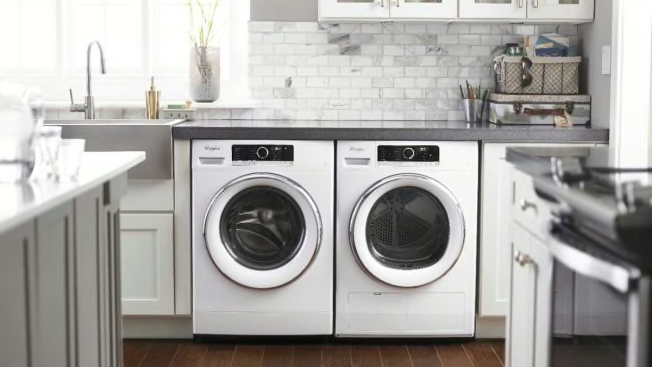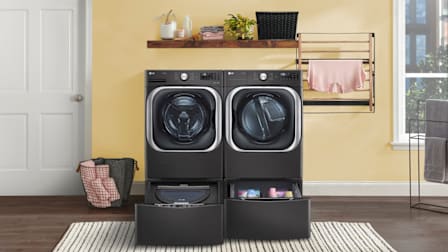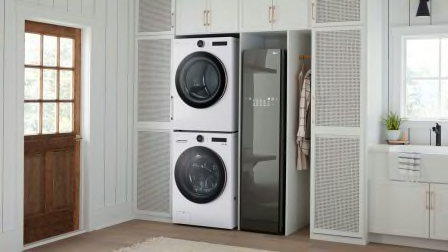The Lowdown on Compact Washers and Dryers
These stackable machines have their quirks, but they may be the best choice for a small space
When you shop through retailer links on our site, we may earn affiliate commissions. 100% of the fees we collect are used to support our nonprofit mission. Learn more.

There’s no magic wand for making huge piles of laundry disappear. If you own a large-capacity washer and dryer, the task will go faster; you can bag those big loads in a few hours. But if you rely on a smaller compact washer and dryer, buckle up. It’s officially laundry day—potentially all day.
Love ’em or hate ’em, stackable compact washers and dryers may be your only choice if your laundry area can’t accommodate full-sized machines. They can still get the job done if you invest in a quality pair. These space-saving machines represent a tiny market share, but they’re gaining in popularity among downsizing retirees as well as younger urban/suburban dwellers organizing their townhouses and condos. Apartment dwellers usually don’t have as much say with their washer-dryer choices, but if they do, compacts are typically a good option.
All of the compact washers we’ve tested are stackable front-loaders, and most perform well. They fall in the same price range as their full-sized cousins and tend to be gentle on clothes, and many are water- and energy-efficient. Seventeen of 24 compact washers in our ratings are Green Choice models, the most eco-friendly models we rate.
Compact Washers Vibrate
Like all front-loaders, compact washers spin fast to extract as much water from clothes as possible, cutting dryer time. That high spin speed in a smallish frame typically causes vibration. And stacking a dryer atop the washer (a typical setup for compacts) doesn’t help in that regard. To cut down on vibration, make sure your compact washer is properly leveled when installed. If vibration becomes a problem, using a lower spin speed may help. Among compact washers we tested, only two got very good scores for vibration and none achieved the highest score. Here they are.
Stacking Kits May Not Be Included
Some compact washer-dryer sets come with stacking hardware included, while others require you to order the kits at an extra cost. Stacking kit prices can be $50 to $250, so it’s something to keep in mind when shopping. All of the compact machines in our ratings are stackable.
Using Bleach Can Be a No-No
Chlorine bleach can negatively affect internal rubber and plastic parts of front-load compact washers. So some compacts don’t offer bleach dispensers. But the availability of safer bleaching agent options means more bleach-dispensing compacts are coming to market compared with the past. Sixteen of the compact washers we’ve tested include a bleach dispenser. Those that have dispensers are identified in our ratings chart.
Detergents and bleaching agents that boast of Oxi or Oxy (a color-safe bleach made from sodium percarbonate) are typically safer for machines. Before buying a compact washer, check the manual to see if bleach can be used.
Most of the compact machines in our ratings—in particular the higher-rated ones—have automatic bleach dispensers. Here are two of those highly rated models.
Compact Dryers Are Only Electric
Gas compact dryers went extinct about a decade ago. That’s why you’ll only see electric dryers in our compact dryer ratings. Keep in mind that all require a 240-volt connection. Some compact washing machines can plug into their companion dryers, which is helpful if you have only one outlet.

Photo: Courtesy of Whirlpool Photo: Courtesy of Whirlpool
Ventless Dryers Usually Take Longer
Our tests found that vented dryers—the kind that exhaust air outside—often dry clothes faster than nonvented models. But only five of the 17 compact dryers in our ratings are the vented variety. A majority are ventless dryers, which require a drain for moisture removal or a reservoir that must be emptied manually after a completed dryer cycle.
In our tests, vented compact dryers took about 1 hour to dry a 6-pound mixed load of laundry, while ventless dryers took from 1½ to 2⅓ hours to dry the same load. Variables such as load size, moisture, clothing type, and dryer type can also make a difference. If you must choose a ventless dryer, it might be helpful to scan washer cycle times in our compact-washer ratings (they range from 60 to 105 minutes) to get a sense of the total time you’ll need to complete a load of laundry. In Europe, where compact machines are the norm, total washer-dryer cycle times can exceed 4 hours.
Compact dryers also have smaller drums, typically 4 to 5.1 cubic feet. This is much smaller than the drums of standard dryers, which range from 7 to 9 cubic feet. That means less air to circulate, which can extend drying times whether your machine is vented or ventless. Below are highly rated compact dryers from our ratings that are vented. The bottom line: With compact dryers, patience is a virtue; they don’t work magic but they will get your clothes dry eventually.
































